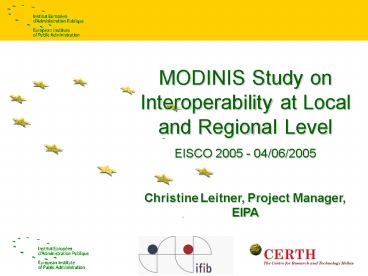MODINIS Study on Interoperability at Local and Regional Level - PowerPoint PPT Presentation
1 / 21
Title:
MODINIS Study on Interoperability at Local and Regional Level
Description:
EIPA - European Institute of Public Administration. CERTH/ITI - Centre for Research and Technology Hellas, Informatics and Telematics Institute ... – PowerPoint PPT presentation
Number of Views:36
Avg rating:3.0/5.0
Title: MODINIS Study on Interoperability at Local and Regional Level
1
MODINIS Study on Interoperability at Local and
Regional Level EISCO 2005 - 04/06/2005 Christine
Leitner, Project Manager, EIPA
2
Consortium
3 partners in the Consortium EIPA -
European Institute of Public Administration
CERTH/ITI - Centre for Research and
Technology Hellas, Informatics and
Telematics Institute ifib -
Institut für Informtionsmanagement Bremen
GmbH
3
MODINIS background - 2
- MODINIS Programme
- (support for the implementation of the eEurope
2005 Action Plan) - Lot 2 Study on interoperability at local and
regional level - Lot 1 Study and services for the reinforcement
of exchange of good practices in eGovernment
(Bearing Point, Fraunhofer IAO) - Lot 3 Study on identity management in
eGovernment (Univ. of Leuven et.al)
4
MODINIS background - 3
- MODINIS Study on Interoperability at Local and
Regional Level is - A support action for the exchange of information
on IOP experiences at regional and local level in
Europe - A means to support the improvement of
cross-border and pan-European IOP - 26 months duration (21/12/04 to 20/02/07)
5
Activities and responsibilities
- The study on IOP at local and regional level
consists of four main activities (work packages)
- Exchange of experiences and case studies ifib
- Local and regional interoperability (IOP) study
CERTH/ITI - Dissemination and promotion of progress and
take-up of interoperability EIPA - Project management EIPA
6
Main objectives
- Intensify the exchange of information on
practical eGovernment interoperability (IOP)
experiences at local and regional level - Support further actions to improve cross-boarder
and pan-European IOP - Identify and analyse cases in IOP to be fed into
the Good Practice Framework (GPF) Portal
(www.egov-goodpractice.org)
7
Expected outcome - 1
- Exchange of experiences and case studies
- Identify stakeholders and multipliers
(public/private) in IOP - Undertake stakeholder needs analysis and feedback
(workshops, networks, etc) - Collect and analyse case studies
- Feed the eGovernment Good Practice Framework
(GPF) (www.egov-goodpractice.org) - Wide dissemination
- Four workshops to results and provide input for
the study 4 formal, some local (if there is
interest) - Discussion forums and other at interoperability
channel in GPF
8
Expected outcome - 2
- Local and regional interoperability study
- Incremental IOP study, including
- Status of local and regional IOP in member states
- Key success factors to IOP
- Key barriers to IOP
- Recommendations to different stakeholder
- Updated version of the study issued every 4
months - Feedback
- Workshops
- Questionnaires
9
What is interoperability (IOP)?
- IOP and integration not yet clearly defined
or distinguished - IOP implies the ability of systems to interlink
and share data, functionalities and processes
within or between organisational entities - IOP is a result of a move to joined-up
government - IOP is a means to solve problems
10
Three aspects of IOP
- Organisational IOP i.e. aspects of
organisational and operational structures
covering political and legal conditions relevant
to the development and use of IOP solutions - Semantic IOP i.e. the ability to exchange and
process data in a meaningful manner through the
use of standardised data elements and metadata
standards - Technical IOP i.e. the use of suitable and
coordinated technologies including questions of
technical IOP architecture
11
Where is IOP needed?
- Between different services referring to the same
customer - Between different stages of a supply chain
producing one or more services - Between single agencies in different geographical
areas - Between directories of services or documents
- In auxiliary services, e.g. identity management,
digital signature etc.
12
Stakeholders - 2
- Six categories of actors
- Public sector
- Private sector e.g. software companies,
consultants and standardisation organisations - European Commission and its agencies
- Other associations, standardisation bodies and
fora - Networks
- Experts from e.g. universities
13
Stakeholders - 1
- Three types of stakeholders
- Champions people who have successfully
implemented eGovernment services or
infrastructures involving IOP - Interested parties people who are actually
involved in projects requiring IOP - Potential/dormant people who should be
interested in IOP due to current or upcoming
projects and/or skill requirements
14
Stakeholders - 3
15
MODINIS Study on Interoperability at Local and
Regional Level
Methodology
16
Layers of IOP
ORGANISATIONAL INTEROPERABILITY
Supporting infrastructure
Coordination of business processes
SEMANTIC INTEROPERABILITY
INSTITUTIONAL CONTEXT (GOVERNANCE)
TECHNICAL/SYNTACTIC INTEROPERABILITY
17
Top-down/bottom-up approach to gather good
practices in IOP
European activities
National programmes
Standardisation
Associations
top-down
Standardisation Bodies
GOOD PRACTICE CASES
Cooperation
bottom-up
Projects initiatives on local
regional level
18
Cases to be considered
19
Assessment criteria of Good Practices in
eGovernment IOP
- A case or service will have to
- Be provided at local or regional level
- Cover elements of a minimum two different levels
of government - Include elements of all layers of IOP
- A case will be assessed further on
- Relevance and transferability
- Innovativeness and effective management
- Real and practical results and impact
- Cross-border cases are of particular interest
20
Study methodology - 1
- The methodology includes 6 iterations (one
iteration every 4 months) - Conduct study and perform analysis, i.e.to
- Understand the status of IOP
- Identify key issues
- Identify key barriers
- Propose suitable recommendations for different
stakeholder groups - Monitor progress and provide feedback (workshops,
online consultation, etc.)
21
- Thank you for your attention
- Contact
- Christine Leitner
- European Institute of Public Administration
(EIPA) - PO Box 1229
- NL-6201 BE Maastricht
- THE NETHERLANDS
- Tel. 31 (0)43 32 96 223
- Fax. 31 (0)43 32 96 222
- Email c.leitner_at_eipa-nl.com
- Web www.eipa.nl































